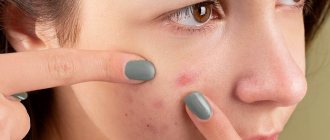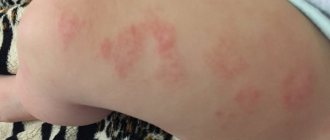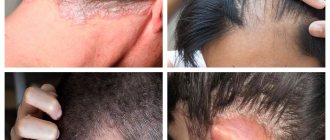- Xerosis, or dry skin. The tendency to it is inherited or occurs as a result of improper care, lack of water in the diet and, for example, when the protective skin barrier is damaged, which leads to increased transepidermal loss of moisture.
- Dermatoses. There is a whole group of diseases that provoke peeling: eczema, atopic dermatitis, allergic dermatitis, hyperkeratosis, etc. It is dangerous to fight them without medical supervision.
- Impact of adverse environmental factors. Dryness after a long walk in the cold or under the scorching sun, as well as after professional chemical peeling or dermabrasion, is inevitable if you do not use protective and restorative cosmetics.
- Some diseases of a non-dermatological nature. The skin on the face may become dry and flaky, particularly in a person with an autoimmune disease or hypovitaminosis. Consult your doctor to rule out internal causes of desquamation.
- Taking a number of medications. Peeling is caused, for example, by diuretics, as well as external agents, creams with high, therapeutic concentrations of acids or vitamin A derivatives.
- Age. Peeling of the facial skin and redness of the skin is observed in older people as a result of a decrease in the natural level of moisture in the dermis and epidermis, and a weakening of the skin’s protective mechanisms. This also happens in early childhood, since the epidermis is just learning to renew itself.
Why do women's faces peel?
In addition to the reasons already indicated, dermatologists associate peeling of the skin on a woman’s face with the onset of menopause or aggressive beauty practices. Thus, excessive use of peelings leads to a thinning of the hydrolipid barrier on the surface of the epidermis. And drying care dehydrates the skin, disrupting the normal mode of exfoliation of “dead” cells.
The habit of constantly following strict diets can also affect the condition of the skin.
Causes of peeling in men
It is believed that since an adult man’s sebaceous glands secrete more sebum than a woman’s, he should not have skin problems. However, regular shaving negates all the advantages: the blade leaves microdamages on the epidermis, and as a result, the integrity of the moisture-retaining hydrolipid layer is disrupted. Not shaving at all is also not an option, because the hairs themselves can cause irritation.
Peeling of the skin on the face in men often manifests itself for a more banal reason - perhaps the only aftershave balm for deep hydration is not enough in your case.
Let's summarize: even knowing why the skin on your face dries and peels, sometimes you cannot do without an experienced dermatologist. But there are some effective measures you can take on your own.
Internal causes of skin peeling:
- One of the most common “internal” causes of flaky skin is allergies. As a rule, it manifests itself in the form of redness, itching and peeling. Allergens can enter the body or act through direct contact. If you suddenly experience severe irritation, remember what unusual products or materials you have encountered recently.
- Also, peeling of the skin on the face can be caused by chronic skin diseases: dermatitis, ichthyosis, eczema, lichen. To diagnose and select treatment, you must consult a doctor.
- But often peeling is caused by a general weakening of the body. To improve the condition of the skin, it is necessary to compensate for the lack of vitamins A, B, E and F.
External causes of skin peeling:
- Peeling of the skin on the face appears especially often in winter - from cold, wind, and frequent contact with hot water. In addition, when the heating is turned on, the air in the room becomes dry and dries out the skin.
- Also in winter we become extremely sensitive to water-based cosmetics. In the cold, water particles freeze directly in our skin, destroying it. Pay more attention to nourishing your skin - don’t forget about a rich cream before going outside, be sure to wear gloves, but don’t wrap yourself completely in a scarf - the same water crystals form on it from breathing.
- In the summer, the skin is dried out by ultraviolet rays and frequent contact with cold water. All this also leads to peeling of the skin. Don't forget to use moisturizer after sunbathing!
- Peeling is often caused by contact with synthetic or harsh materials that irritate sensitive skin.
- Peeling of facial skin can occur due to improper care. This can often be avoided by following good hygiene standards - cleansing and moisturizing the skin before applying cosmetics and after removing them.
Varieties
The nature of the burning sensation depends on the nature of its origin. There are two large archetypes, which include smaller species:
- Physiological type (irritation from external factors):
- burns (solar, chemical, thermal);
- a bite of an insect;
- prolonged friction of the skin, for example, on rough clothing;
- reaction to dry, warm air;
- abrasions, bruises, bruises;
- Pathological type (changes in mentality or condition)
- mental instability;
- changes in physiological state (pregnancy, old age);
- depression;
- feeling of psychological discomfort;
- stress.
Often the symptoms of a mixed type of burning appear, where both signs of a pathological disorder and physiological ones can manifest themselves.
What are red spots on the face?
Red spots appear on various parts of the facial skin. By assessing the location, type and additional symptoms, a preliminary diagnosis can be made.
Localization
In some diseases, red spots are localized in certain areas:
- nose - allergies, infectious diseases, demodicosis, fungal diseases, rosacea, lupus erythematosus, stress, hormonal imbalance and others;
- chin - allergies, rosacea, scleroderma (connective tissue disease), irritation, hormonal imbalance and others;
- cheeks - allergies, rosacea, rosacea, lupus erythematosus, infectious diseases, elevated body temperature, smoking, alcohol consumption, poor diet, diseases of the vascular system and others;
- forehead - seborrhea, allergies, red versicolor, irritation, rosacea and others;
- area around the eyes - irritation, inflammatory diseases of the eye sockets, kidney disease, fatigue, hypertension and others;
- near the mouth - allergies, helminthiasis, gastrointestinal diseases, fungus, infectious diseases, herpes and others.
Appearance: Spots may peel or become wet
In some diseases, red spots can form on any part of the face and even spread throughout the skin. Therefore, it is necessary to take into account the appearance of the stains.
- dryness, peeling, tightness - allergic reaction, dehydration, chapping, burn;
- weeping spots - eczema, dermatitis;
- raised spots - subcutaneous acne, vitamin deficiency, infectious diseases, fungi;
- swelling - inflammation, ripening pimple;
- swelling - kidney disease, allergies, diathesis;
- pus - inflammation, purulent pimples, severe form of fungus.
Symptoms
The appearance of red spots can be accompanied by a number of unpleasant signs. Most often there is a burning sensation, itching or pain. In addition, the spots may itch and peel.
However, you should not give in to temptation and scratch them, since damage to the skin can aggravate the situation. The listed signs often indicate the presence of skin diseases. A feeling like your face is on fire indicates high blood pressure.
Nature of manifestation of irritation
Red spots can be acute or chronic, depending on the cause. In the presence of chronic diseases, red spots appear periodically or do not leave the skin.
Temporary redness goes away after a few days or weeks and usually does not return.










